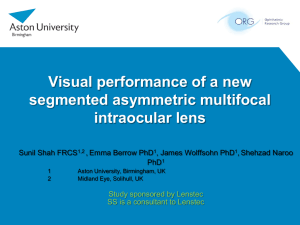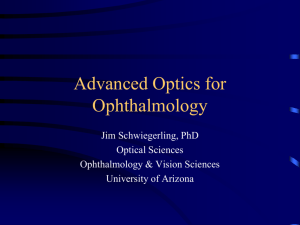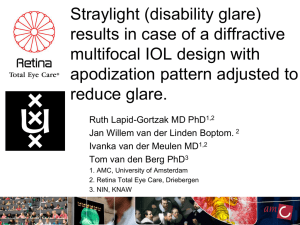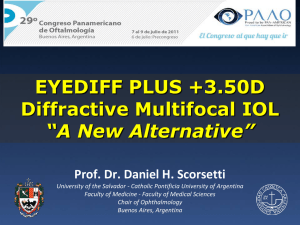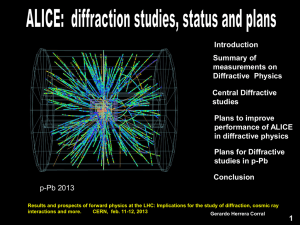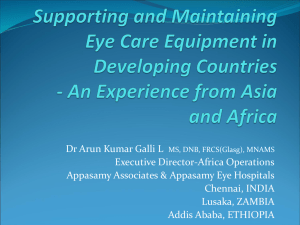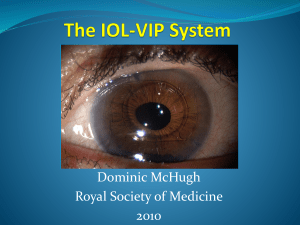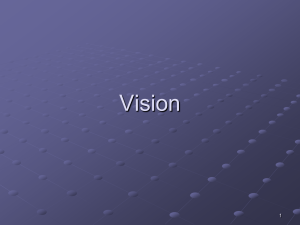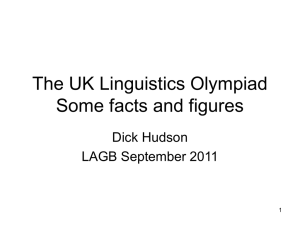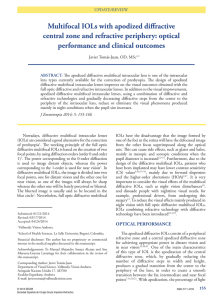PowerPoint-presentatie
advertisement
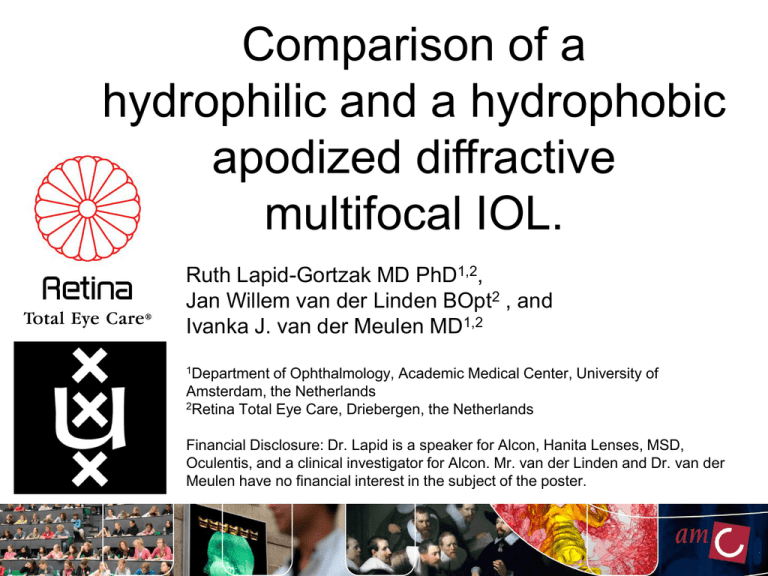
Comparison of a hydrophilic and a hydrophobic apodized diffractive multifocal IOL. Ruth Lapid-Gortzak MD PhD1,2, Jan Willem van der Linden BOpt2 , and Ivanka J. van der Meulen MD1,2 1Department of Ophthalmology, Academic Medical Center, University of Amsterdam, the Netherlands 2Retina Total Eye Care, Driebergen, the Netherlands Financial Disclosure: Dr. Lapid is a speaker for Alcon, Hanita Lenses, MSD, Oculentis, and a clinical investigator for Alcon. Mr. van der Linden and Dr. van der Meulen have no financial interest in the subject of the poster. INTRODUCTION Multifocal IOLs (MFIOL) effectively treat ametropia and presbyopia. Satisfaction with MFIOLs depend on patient motivation and on the design of the IOL optic. Most optics use a refractive or diffractive pattern to separate the light into 2 foci – 1 for far and 1 for near. This causes a blur circle of the focus that is not clear, but also other visual side effects. In apodized diffractive MFIOLs the ring pattern on the optic is a source of halos and visual side effects. Changes in this design could lead to a decrease in visual side effects. The diffractive rings on the optic allow for separation of different foci, and apodization, which is the different height and distance of each ring, allows for a more clear separation of different foci, and the precise design of these apodized diffractive rings influences the balance between: 1.Distance versus near dominance of a MFIOL 2.Induction of halos by the ring pattern 3.Depth of focus of the near focus PURPOSE: To compare outcomes between a new design apodized diffractive hydrophilic multifocal IOL( Seelens MF; study group), and a well-known apodized diffractive hydrophobic multifocal IOL (SN6AD1; control group). The IOLs Seelens MF(Hanita Lenses, Israel) Hydrophilic material Optic 6 mm, haptic 13 mm Aspheric, biconvex, posteriorly angulated haptics 50 11 apodized diffractive rings 3600 posterior square edge of optic reading addition: +3.0 D SN6AD1 (“Restor +3”) (Alcon, USA) Hydrophobic Acrysof material Optic 6 mm, haptic 13 mm Aspheric, biconvex, not angulated 9 apodized diffractive rings square edge of optic & haptics reading addition: +3.0 D METHODS comparative case series / refractive and visual outcomes at distance and near / dysphotopsia and straylight measurement scores / at 3 months postoperatively. Figure 1: Mean uncorrected distance visual acuity (UCDA) up to 6 months form surgery. At all time points measured postoperatively the study group and the control group performed equally in terms of uncorrected distance visual acuity and was not statistically significantly different. @ 3 months: Seelens MF logMAR 0.02 + 0.07 vs SN6AD1 0.04 + 0.09. Figure 2: The comparison of the postoperative corrected distance acuity up to 6 months is shown. The difference between the groups is small but statistically significant in favour of the study group (the Seelens MF) -0.04 + 0.05 vs control group (SN6AD1) -0.1 + 0.04 ( <0.019). Figure 3: UNVA at 40 cm, at different time points in the follow up period. The study group and the control group perform equally well: logMAR Seelens MF 0.09 + 0.12 versus SN6AD1 0.08 + 0.08. There were no clinical or statistically significant differences between the groups. Ocular Parameters: Study vs Control Group Parameter Sphere (D) Cylinder (D) Spherical Equivalent (D) Axial Length Anterior Chamber Depth Study Group Control Group P value Mean + SD 1.14 + 1.59 0.31 + 3.12 Range -3.5D to +5.75D -6.5D to +5.25D Mean + SD -0.45 + 0.38 -0.67 + 0.32 Range 0 to -1.25 -0.25 to -1.50 Mean + SD 1.19 + 1.68 -0.02 + 3.06 Range -3.88 to +5.13 -6.88 to +5.00 mm + SD 23.47 + 1.56 23.84 +1.78 Range 22.17 to 25.54 21.01 to 27.45 mm + SD 3.33 + 0.12 3.24 + 0.43 Range 2.61-3.93 2.70-4.56 3.39 + 0.21 3.46 + 0.85 2. to 4.1 2.3 to 4.6 Preoperative Pupil Diameter mm + SD Range 0.051 0.009 0.035 0.30 0.34 0.49 Visual quality, Halos, and Patient Satisfaction • • • Straylight changed (improved) from a mean log S of 1.276 + 0.078 in the Seelens MF group to 1.077 + 0.237 (p<0.0001). In the SN6AD1 group straylight reduced less from 1.243 + 0.594 preoperatively to 1.189 + 0.0194 postoperatively (P<0.25). The mean difference between the study and the control group postoperatively was a -0.12 log S in favour of the study group (p<0.002). Halos were reported at 3 months in 3 (12%) of patients in the study group and 5 (28%) of patients in the control group. This difference did not reach statistical significance, even though there is a clinical significance. Satisfaction Overall 24 (96%) in the study group were satisfied with the multifocal IOLs. In the control group 19 (95%) patients were satisfied with the surgery and the effect on vision. Clinically and statistically there is no difference in the satisfaction between the study and the control group. CONCLUSIONS: 1.The Seelens MF performs well compared to a well known multifocal apodized IOL, the SN6AD1 in terms of distance and near acuity 2. The lens material and design of the Seelens MF clinically and statistically significantly improves straylight and quality of vision. 3. Clinically the incidence of halos was less in the study group, however this was statistically not significant.
